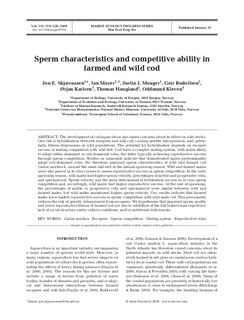Sperm characteristics and competitive ability in farmed and wild cod
Skjæraasen, Jon Egil; Mayer, Ian; Meager, Justin J.; Rudolfsen, Geir; Karlsen, Ørjan; Haugland, Thomas; Kleven, Oddmund
Journal article, Peer reviewed
Permanent lenke
http://hdl.handle.net/11250/108810Utgivelsesdato
2009-01-27Metadata
Vis full innførselSamlinger
- Articles [3009]
Originalversjon
http://dx.doi.org/10.3354/meps07774Sammendrag
The development of cod aquaculture has raised concerns about its effect on wild stocks. One risk is hybridisation between escapees and wild cod, causing genetic introgression, and, potentially, fitness depressions in wild populations. The potential for hybridisation depends on escapee success in mating competition with wild fish. Cod have a complex mating system, with males likely to adopt either dominant or sub-dominant roles, the latter typically achieving reproductive success through sperm competition. Studies on salmonids indicate that domesticated males predominantly adopt sub-dominant roles. We therefore analysed sperm characteristics of wild and farmed cod Gadus morhua L. around the onset and end of the natural spawning season. Wild and farmed males were also paired in in vitro crosses to assess reproductive success in sperm competition. In the early spawning season, wild males had higher sperm velocity, percentages of motile and progressive cells, and spermatocrit. Sperm velocity was the main determinant of fertilisation success in in vitro sperm competition and, accordingly, wild males had higher reproductive success. At the end of spawning, the percentages of motile or progressive cells and spermatocrit were similar between wild and farmed males, but wild males maintained higher sperm velocity. Our results indicate that farmed males have limited reproductive success in sperm competition with wild male cod. This presumably reduces the risk of genetic introgression from escapees. We hypothesise that impaired sperm quality and lower reproductive fitness of farmed cod are due to inhibition of the full behavioural repertoire, lack of social structure under culture conditions, and/or nutritional deficiencies.
